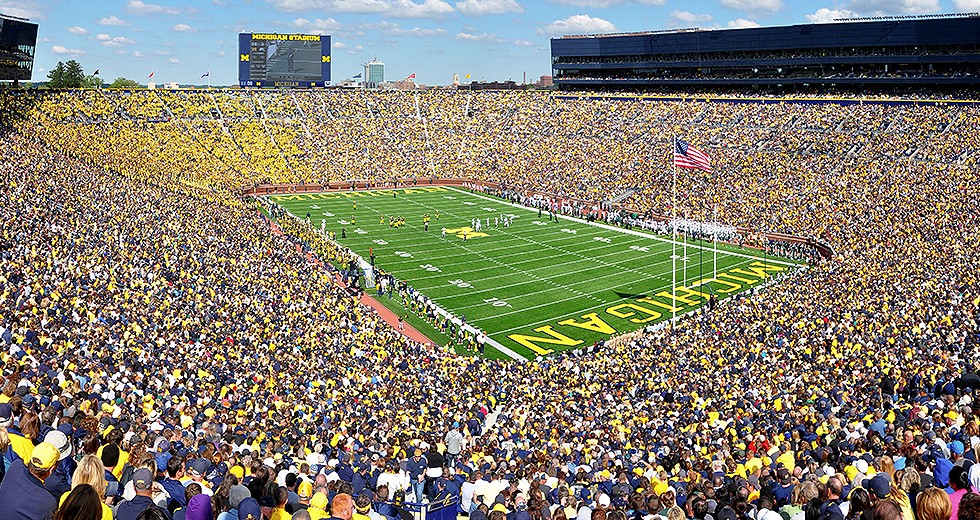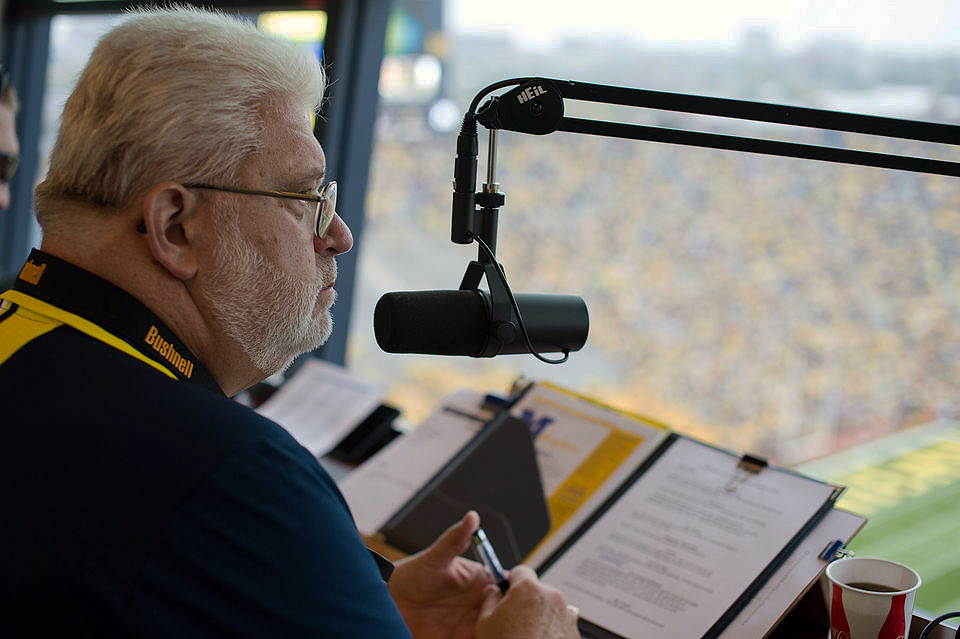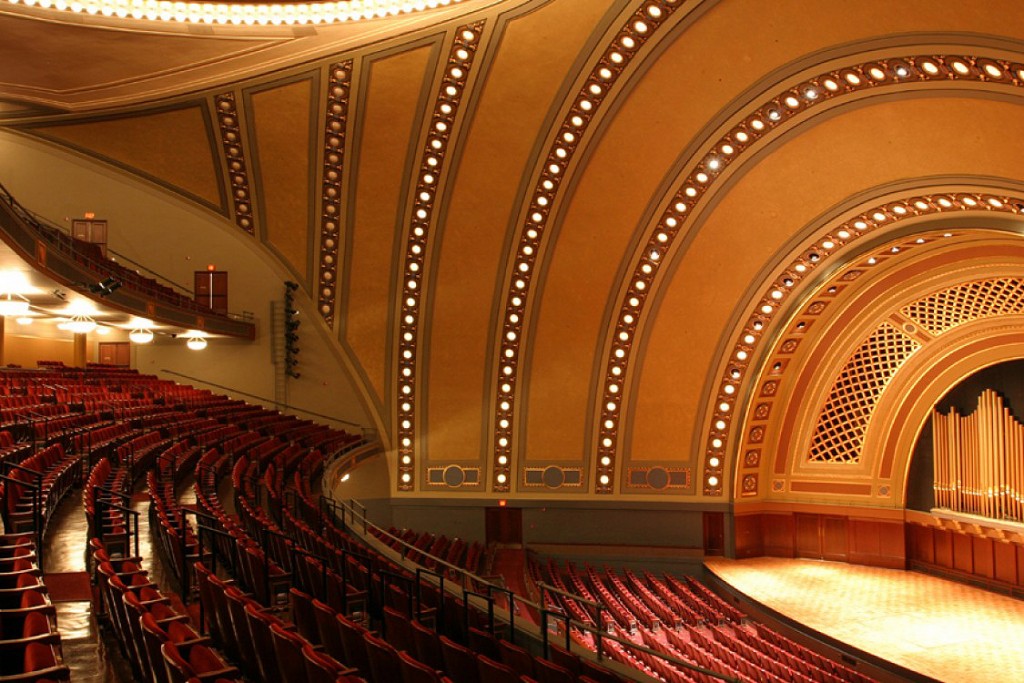
Mention Ann Arbor’s “Big House” to music fans, and you’re just as likely to hear about the University of Michigan’s century-plus Hill Auditorium as Michigan Stadium’s century-mark capacity.
Few cities can compete with the 88-year-old stadium’s 107,601 benches — football’s most — and fewer still with the concert hall’s 3,500 seatbacks, which trump Chicago’s Orchestra Hall by a thousand.
“Hill Auditorium and Michigan Stadium — two of my favorite places!” says WFMT radio host Carl Grapentine, Chicago’s Ann Arbor authority. Since 1970, he’s been the voice of the Michigan Marching Band, and the gridiron’s play-by-play announcer for 11 seasons. He’s a Hill concertgoer since 1959 — “Haven’t missed a year since.”
Second in a series: Concert halls and iconic venues in cities the CSO tours
The 1913 auditorium, which music director Riccardo Muti and the Chicago Symphony Orchestra visit Thursday, dates from an era when oratory was blustery and microphones were rare. The university wanted a venue where lecturers could easily reach large audiences. So it turned to a pioneering industrial architect with innovative acoustical ideas.

Chicago radio host Carl Grapentine is the voice of Michigan Stadium and the Michigan Marching Band. | Photo: Ann Arbor News
Albert Kahn (1869-1942) is best remembered for the Ford Motor Co.’s River Rouge colossus, heroic in Diego Rivera’s “Detroit Industry” murals, and in 1937, a turbulent black-and-white backdrop when Wagner Act (senator Robert) union organizers and management heavies collided. Kahn’s Packard Automotive Plant, with its terse lines and sprawling scale, is now Detroit’s grandest ruin — the Motor City’s challenging monument to strength, dominance and decline.
Ann Arbor’s Hill Auditorium, which the CSO inaugurated in 1913, remains the architect’s most inspired effort and, like Kahn’s factories, it begins with a straightforward sense of how a large space best serves its function. The concert hall isn’t without flourishes, but the ornament grasping its columned façade and telescoping interior vaults — even the Michigan “M” at its apex, a Grapentine favorite — seems always to highlight the auditorium’s structure.
That structure — Kahn’s innovation — is an elliptical volume with the stage near its tip. Sound ricochets around its vertical and sideways arcs, then shoots toward the audience with focused clarity. In balcony seats above the mezzanine, which Grapentine credits with “a presence that is amazing to hear, especially when seated near the middle,” soloists seen on the right are often heard from the left in stunning, if disorienting, brilliance. Music bounces and blends everywhere.
Visually, Hill Auditorium is like piloting a seven-aisle wide-body aircraft, row after row of passengers sitting 67 abreast; there are plenty of middle seats. The audience gets a cockpit crew’s perspective, facing directly into the narrowing nosecone. Instead of flight controls, the orchestra’s gathered up front, recalling that throwaway joke from “Airplane!” — “They’re on instruments!”
Certainly the most expansive of Ann Arbor’s visuals comes from the cramped benches atop the southeast rim of Michigan Stadium, gaping across a green gridiron sea toward packed students on distant maize shores, their cheers the percussive whip for massed-brass oarsmen toiling below — the valiant Michigan Marching Band. But as the Big House keeps growing and larger crowds float in, new game-day sounds are increasingly dividing the Wolverine faithful.

Listen left and look right in Ann Arbor’s Hill Auditorium, defined by its nose-cone shape. | Photo: Fisher Dachs Associates
Michigan Stadium, a traditional sunken bowl scooped out by Osborn Engineering — the Cleveland firm that built the Bronx’s Yankee Stadium (1923) and a host of classic ballparks — has always subsumed form to function with a respect that Hill Auditorium’s Kahn must have admired. Ann Arbor hewed to the bowl design in subsequent expansions (when new in 1927, the stadium held 72,000; smaller Yankee Stadium opened with seats for 58,000), adding row after row atop “A” Squared’s squared oval.
Recent renovations, completed in 2010, charted a new course. Michigan Stadium added two five-story press/skybox towers plus large video scoreboards, substantially altering the sideline and end-zone heights beyond the bowl’s top rows.
Now there’s piped-in music — rock power ballads that keep Wolverine paws pumping (front and forward — they’ve always hailed heart to sky for “The Victors,” Michigan’s iconic fight song), making the Big House one of college football’s loudest. “I’m not in favor of it, but it’s the way of the world,” announcer Grapentine realizes. “They have been able to refine the various components over the last several years to make [the music] more harmonious.”
Like coaches and quarterbacks, Grapentine and the band are learning to manage delays and check the ticking seconds. The public-address system that used to sit atop a sideline press box — Grapentine’s announcing perch, now towering above the bowl — was shifted to a lower spot in the end zone. “All of the speakers are now in the north scoreboard facing south, which means I hear my own voice coming back at me a full second later after I’ve spoken the words,” he explains. “I’m used to it now, but it can be very disconcerting.”
The band is newly amplified, except during pre-game and halftime shows, to match its volume to the pre-recorded stadium riffs. Grapentine often senses the “raw” sound of the band competing with the amplified sound of the band. Michigan’s trombones and tubas adjust to their own fanfares tossed back at them all afternoon, a second later and a smidge louder, like playing act after Wagner act (composer Richard) in Bayreuth’s sunken orchestra pit — it’s supposed to all blend together.
But not always easily. Valiant hails that used to float above the bowl slam back off skybox glass. The band, on the west sideline, battles its own amped echo and checks the ticking seconds. Brash stadium jams fly southbound from the end zone, pumping fans for certain victory. Michigan’s punter flubs a northbound snap — it ricochets right to Michigan State.
The Big House falls silent. A Spartan sound this October.
Andrew Huckman is a Chicago-based lawyer and writer.
TOP: Michigan Stadium, Ann Arbor’s “Big House,’’ is the Big Ten’s largest — and most likely loudest — arena. | Photo: Wikipedia Commons